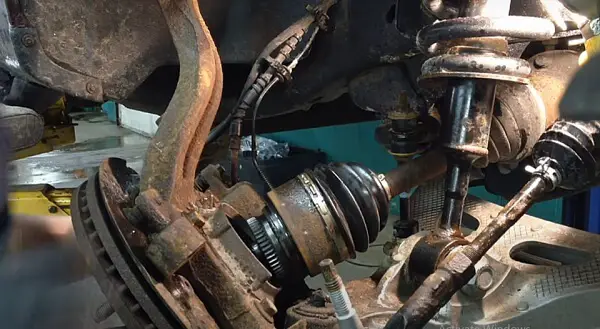The Ford F150 typically has IWE (Integrated wheel ends) to engage and disengage 4WD using a vacuum source from the engine intake or vacuum pump.
The IWE consists of a hub actuator with internal gears which lock and unlock with the wheel hub gears based on the availability of the vacuum.
People often experience an issue with this vacuum-assisted IWE system and end up with hub actuator noise in Ford F150.
Depending upon the severity of the issue, the noise could be irritating especially when you are driving in an isolated place away from city traffic.
The main reasons for the F150 hub actuator noise would be a vacuum leak in the IWE system, a faulty check valve, a malfunctioning vacuum solenoid valve, or a faulty hub actuator.
If you are facing the issue of hub actuator noise and are interested to know the details, reasons, and solutions to fix it. You are at the right place. Stay tuned!
Table Of Contents
How Does F150 Hub Actuator Works?
The hub actuator usually has two nozzles. The bigger nozzle is connected to the vacuum solenoid which applies vacuum to the hub actuator and the smaller nozzle is a return vent connection.
The vacuum solenoid is operated by the 12V ECU signal depending upon the driver input from the dash. The solenoid is connected to the vacuum reserve box and series of check valves on the input side and IWE on the output side.
The check valves help in accumulating the vacuum in the vacuum reserve box otherwise the vacuum build-up would be lost. Because of the vacuum reserve box, whenever 2H mode is selected, the vacuum would be immediately applied to disengage the hub actuator to enable 2WD mode.
When the vehicle is running, the engine intake vacuum supplies suction pressure to the vacuum solenoid through a one-way check pressure.
Depending upon the drive mode selected, the vacuum solenoid applies or releases the vacuum supplied by the engine to the hub actuators.
When we select a 2H mode on the dash, the ECU actuates the vacuum solenoid to apply vacuum to the hub actuator which pulls back the internal gears with the help of the diaphragm and the hub actuator disengages the drive shaft gear from the wheel hub. Hence the wheel rotates freely irrespective of the drive axle.
In the case of 4H drive mode, the vacuum solenoid closes the output side and stops supplying the vacuum source to the hub actuator hence the diaphragm releases the hub gears and that would lock the wheel hub with the drive axle gears.
Experiencing F150 Hub Actuator Noise? 4 Reasons And Solutions To Fix It!
The hub actuator is supposed to either fully engage or disengage the wheel hub with the drive axle gears whenever it gets a vacuum supply from the vacuum solenoid.
But in some cases, the hub actuator partially engages with the wheel hub and creates a typical F150 hub actuator grinding noise. Below are a few reasons for the F150 hub actuator noise.
Vacuum leak
One of the main reasons for the F150 hub actuator noise would be a vacuum leak in the IWE system.
A vacuum leak in the hoses getting connected to the hub actuator can cause partial disengagement of the hub actuator with the wheel hub gears which can cause grinding noise in the F150 hub actuator. The hub actuator in that case would neither fully engaged nor disengaged.
The F150 hub actuator noise typically happens in 2WD. It is because the vacuum plays a role only in 2WD mode. In 4X4 4H mode, the vacuum will be released from the hub actuator, so there is no question of a vacuum leak in the absence of a vacuum.
To check vacuum leaks, you can connect the vacuum gauge to the larger nozzle on the hub actuator and apply a vacuum. If the vacuum is getting hold without any loss then it indicates no vacuum leak.
A vacuum loss of 1 lb over 1 minute is acceptable. Also, check that you get a minimum of 5 lb of vacuum to disengage the hub actuators.
The vacuum leak could be due to a crack in the vacuum hoses or IWE hub actuating diaphragm, hoses coming off from the nozzles on the IWE hub actuator, or a leak at either the vacuum reserve box or engine intake.
You need to thoroughly investigate various IWE system parts for vacuum leaks starting from the engine intake to the hub actuator via. the vacuum reserve box and vacuum solenoid valve and replace the parts based on inspection.
Alternately people bypass the F150 4X4 hub actuator to get rid of the partial disengagement problem which leads to hub actuator noise in Ford F150.
To bypass the hub actuator you would need to either disconnect the vacuum hoses from the vacuum solenoid or the IWE nozzles.
Another option could be to install a vacuum actuator delete kit which would permanently connect the drive axle to the wheel hub without the need for a vacuum source.
The drive CV axles would turn continuously along with the wheels, but without switching to 4WD mode the transfer case would not be engaged, do the front driveline would not have power and not provide torque.
So, your F150 would have 4X4 capability whenever required without being 4WD all the time. Since the actuators are engaged all the time, hub actuator noise will not recur.
Faulty check valve
If the vacuum levels which is getting supplied to the hub actuator are less, then also the vacuum will not be sufficient to completely disengage the hub actuators.
A faulty check valve that sits just before the vacuum solenoid will prevent the desired vacuum from getting applied downstream to the vacuum solenoid and IWE.
The check valve is a one-way valve that allows flow in one direction toward the IWE actuator. The engine vacuum shall open the valve and engine manifold pressure in WOT condition will close it.
If you can blow air in both directions of the check valve, then it indicates it is time to replace the check valve with a new one.
Malfunctioning vacuum solenoid
In earlier models, the vacuum solenoid which is mounted between the battery and the passenger firewall under the hood is open for direct water entry without any water protection cover.
The water from the windshield wiper gets accumulated under the hood where it enters the vacuum solenoid and shorts it.
A faulty vacuum solenoid valve would not apply complete vacuum to the IWE in 2H 2WD mode and that creates partial disengagement of the hub actuator which leads to F150 hub actuator noise between the participating gears.
Hence it is essential to replace the faulty vacuum solenoid with a new one before it results in costly repair operations.
Moreover, in the case of the latest vacuum solenoid design, ford has provided a hat cover over the vacuum solenoid to prevent water entry, so the chances of hub actuator noise getting repeated would be very less.
Faulty hub actuator
Once water enters the vacuum solenoid and damages it, the water would find its way into the IWE hub actuator too.
The water entry into the IWE may try to freeze and block the vacuum supply to the hub actuator. Insufficient vacuum getting applied to the IWE would cause partial disengagement of the hub actuator from the wheel hub which leads to grinding hub actuator noise.
Often the diaphragm in the IWE gets damaged and leaks vacuum which leads to hub actuator noise since it will not be able to completely disengage the hub actuators for that reason.
So, whenever you suspect water entry in the vacuum solenoid valve, you would need to dismantle the hub actuator and check for water entry and clean the IWE, drive axle, and wheel hub gears, and apply grease for smooth functioning.
If you observe rusting inside the hub actuator and gear teeth are found worn -out or damaged, then you need to replace the IWE with a new one.
When the engine is running and the drive mode is in 4H, you shall not be able to move the drive axle with ease simply by rotating the wheel, otherwise, there is a problem with the IWE on that side.
Conclusion
The most common reason for the F150 hub actuator noise would be a vacuum leak in the IWE system. A simple inspection of the vacuum hoses and replacing the damaged hoses may solve the hub actuator noise issue in most cases.
If you have an old-style vacuum solenoid without a protection hat over it, then replacing the faulty vacuum solenoid can be one of the solutions.
The fix can be as simple as replacing a faulty check valve which leaks vacuum and leads to hub actuator noise in F150.
It is recommended to carefully analyze and troubleshoot the IWE system parts one after another to permanently fix the problem.
Once you know the root cause, it will be easy to fix the noise issue. If you are not comfortable to diagnose the issue, then you may show the vehicle to a qualified mechanic to fix things.
Happy Motoring!
References
https://www.f150forum.com/f2/grinding-noise-grease-leaking-behind-hub-4×4-actuator-496237/
https://www.ford-trucks.com/forums/1643706-4×4-actuator-grinding-noise.html
https://www.fordf150.net/forums/viewtopic.php?t=116437
Related Articles
F150 Grinding Noise When Accelerating? 8 Reasons And Solutions To Fix It!
Ford F150 knocking noise when starting? 11 Causes And Solutions To Fix It!
Ford F150 Front End Noise When Turning? 12 Causes And Solutions To Fix It!
Ford F150 Rear End Clunk? 7 Reasons And Solutions To Fix It!
Ford F150 Rear End Vibration? 11 Causes and Solutions to Fix It!
Ford F150 Rear End Vibration When Turning? 6 Causes And Solutions To Fix It!
Why the Car Shakes In Reverse? 7 Causes And Solutions To Fix It!
How To Replace F150 Differential Clutch Pack (With Replacement Cost)?


